Plants birds love in the winter garden
As frost descends and the leaves gather on the lawn, the most important colour is red because it glows against the backdrop of fading stems in muddy shades of khaki, grey and brown. Red’s the colour that fixes the rest of the palette and luckily red berries and fruit are abundant from autumn. The most palatable are gobbled up by the birds, particularly thrushes and blackbirds who seem to adore fleshy fruit.

The comings and goings of the birds will add another dimension to the garden, and you can attract even more by making sure you have some of these edible fruits. One of the most magnificent is Cotoneaster ‘Cornubia’, a big, vigorous semi-evergreen with huge clusters of red berries that weigh down the branches. Generally the berries survive until after Christmas before being devoured by marauding fieldfares and redwings, so this large shrub is a real winter spectacle. The more modestly sized (but still substantial) Cotoneaster lacteus has smaller fruits that also last until winter, but the sumptuous grey-backed, green leaves make up for its less spectacular berries. The foliage catches the frost to great effect, looking almost as though they’ve been dredged in icing sugar by an enthusiastic child.
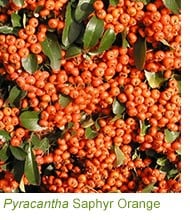 Cotoneaster berries manage to linger into winter, but the orange or red berries of Pryracantha ‘Saphyr Rouge’ and ‘Saphyr Orange’ disappear into the grateful beaks of blackbirds and thrushes without any ceremony. They gobble them with greedy enthusiasm, but fortunately the berries do form early so there’s still plenty of time for them to shine. The Saphyr varieties are extremely hardy and fireblight-resistant. They do well against north and west-facing walls, looking most effective when trained onto a framework of wires. They can also be used as a hedge, and pyracantha foliage is a high-gloss affair, so it shines even without any berries.
Cotoneaster berries manage to linger into winter, but the orange or red berries of Pryracantha ‘Saphyr Rouge’ and ‘Saphyr Orange’ disappear into the grateful beaks of blackbirds and thrushes without any ceremony. They gobble them with greedy enthusiasm, but fortunately the berries do form early so there’s still plenty of time for them to shine. The Saphyr varieties are extremely hardy and fireblight-resistant. They do well against north and west-facing walls, looking most effective when trained onto a framework of wires. They can also be used as a hedge, and pyracantha foliage is a high-gloss affair, so it shines even without any berries.
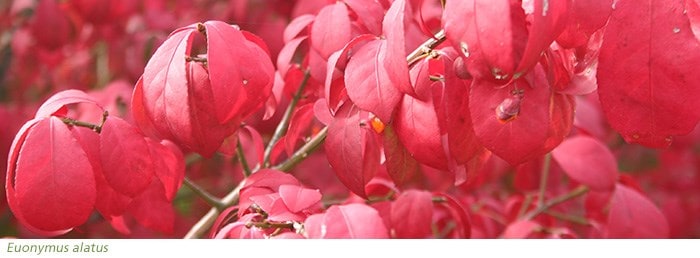
The spindle berries, or Euonymus, also provide early fruit and the foliage colours up well in September to lipstick-pink. As a result they are sometimes known as ‘fire’ bushes. They drop their leaves early, but Euonymus alatus will bear lots of purple-pink and orange winged fruits and these swing away from the bush like chairs on a fairground ride. They’re highly nutritious and adored by robins and it’s said that males will fight to the death in order to protect a heavily loaded spindle bush. As winter descends, a mature specimen will also display corky wings on its grey-brown stems. Although E. alatus is slow-growing, the hard wood was used to make spindles, hence the name.
Hollies are equally popular and their berries normally disappear in the weeks before Christmas. If you want to beat the birds, pick them four weeks before the big day and place them somewhere cool and dark. Spray them with water to keep them glossy and fresh. Like many shrubs hollies are divided into female and male varieties, a condition known as being dioecious. Only the females produce berries, but pollen is needed from the male. In towns and cities plenty of pollen is already available. In isolated areas you will have to have a male and a female.
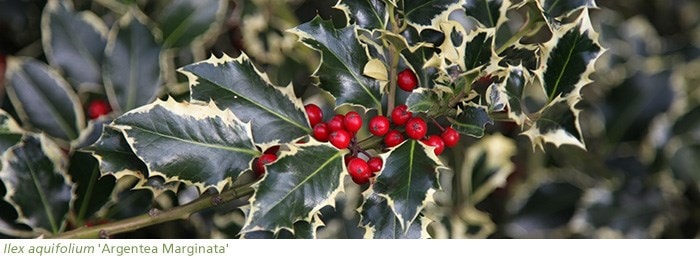
The heaviest ‘berriers’ are forms of English holly, Ilex aquifolium. Beware though of the prickly leaves for aquifolium describes the eagle’s (aquila’s) talons, so these slow-growing evergreens need careful positioning. They are not finger friendly in borders and they only berry when left to grow, so clipping them into topiary isn’t a good idea should you want them to fruit. Ilex aquifolium 'Argentea Marginata’ forms a small bushy tree and the green spiny leaves have creamy yellow margins, so it’s brighter than the all-green version.
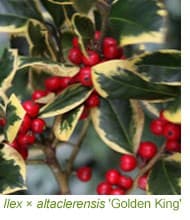 The smoother-leaved Highclere holly (Ilex × altaclerensis) is gentler on the fingers. Discovered at Highclere Castle near Newbury in Berkshire, now famous as Downton Abbey, one of the best is Ilex × altaclerensis 'Golden King’. This is a female ‘berrier’, despite its manly name, and the oval leaves are a mottled mixture of grey-green and darker-green roughly margined in custard-yellow, so it glows in winter light. There are fewer berries, but this kinder-to-the-touch holly makes a good hedge, or it can be topiarized into a lollipop, or wedding cake. Clipping will always be at the expense of berries of course. No matter, because any evergreen shrub will help shelter wildlife, including your birds. They also provide blocks of colour, so are invaluable in the garden.
The smoother-leaved Highclere holly (Ilex × altaclerensis) is gentler on the fingers. Discovered at Highclere Castle near Newbury in Berkshire, now famous as Downton Abbey, one of the best is Ilex × altaclerensis 'Golden King’. This is a female ‘berrier’, despite its manly name, and the oval leaves are a mottled mixture of grey-green and darker-green roughly margined in custard-yellow, so it glows in winter light. There are fewer berries, but this kinder-to-the-touch holly makes a good hedge, or it can be topiarized into a lollipop, or wedding cake. Clipping will always be at the expense of berries of course. No matter, because any evergreen shrub will help shelter wildlife, including your birds. They also provide blocks of colour, so are invaluable in the garden.
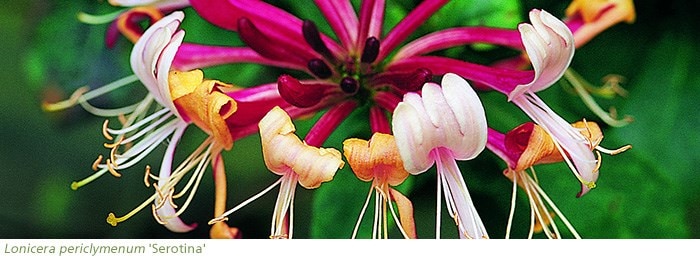
In mid-winter honeysuckle will produce berries too, and piled together like giant raspberries they are a huge draw for the birds. I’ve seen waxwings gorging themselves on sunny, crisp winter days so you may be lucky too. All forms of Lonicera periclymenum, including the dark-pink and yellow ‘Serotina’, the pallid-yellow ‘Graham Thomas’ and the red and yellow ‘Rhubarb and Custard’, berry up well. In summer they bear fragrant flowers, designed to attract moths and butterflies, and they make good scramblers in a hedge. Honeysuckles take time to establish and, if you can dig a long trench and lay the plant in the ground before covering it lightly, it should root more easily. Leave the top exposed though.
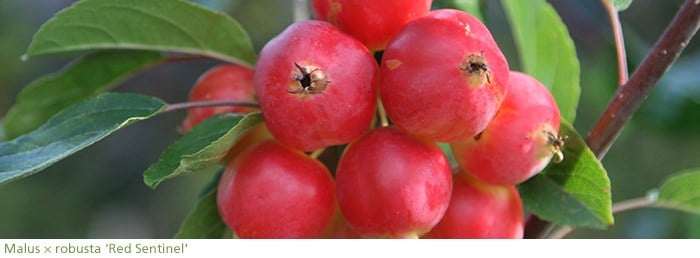
Red crab apples are devoured by birds from January onwards, so you still get to enjoy them for many a month before they disappear. Malus x robusta ‘Red Sentinel’ lives up to its name well, glowing in winter light as it clings on to its round, red crab apples. The branches will also make good hangers for bird feeders too - otherwise the Deluxe Bird Feeding Station kit will hold several different feeders and you can site it close to a good indoor vantage point, for those days when it’s too bleak and cold to venture out.
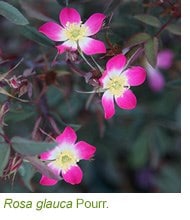 Rose hips are not always very bird-friendly, despite being good on the eye. However the smooth-stemmed, grey-leaved species shrub rose, Rosa glauca, is adored by agile finches and tits who swing through the branches like circus performers on a trapeze, stripping out the pulp and seeds for their breakfast and supper. An airy shrub rose, it’s grown for its dusky foliage and flagon-shaped orange hips rather than the single pink flowers which are frankly boring. It’s medium-sized and rangy and needs space to shine. In hot summers the foliage develops smoky, grey tints, in shades of gunmetal, like smoke rising after a gunfight. And it’s perfect in a hot spot, with silvers, on poor soil.
Rose hips are not always very bird-friendly, despite being good on the eye. However the smooth-stemmed, grey-leaved species shrub rose, Rosa glauca, is adored by agile finches and tits who swing through the branches like circus performers on a trapeze, stripping out the pulp and seeds for their breakfast and supper. An airy shrub rose, it’s grown for its dusky foliage and flagon-shaped orange hips rather than the single pink flowers which are frankly boring. It’s medium-sized and rangy and needs space to shine. In hot summers the foliage develops smoky, grey tints, in shades of gunmetal, like smoke rising after a gunfight. And it’s perfect in a hot spot, with silvers, on poor soil.
 Perhaps the most bird-friendly thing you can do is to leave your late-flowering perennials intact until after the worst of the winter. They will catch the frost and most are stiff-stemmed enough to stay upright, although do cut away anything that collapses in a sappy mess. Seed eating birds will feast on the seeds of teasels, asters (some now renamed symphyotrichum), sanguisorba’s and various daisies such as echinacea and rudbeckia. The twiggy stems and spent flower heads will shelter small insects, and wrens are very fond of frisking through them for food. The stems will also provide extra shelter at ground level, helping to protect tenderish plants such as crocosmia and kniphofia, from the worst of the winter. Leaving plants intact also prevents the garden from being a bare-earth landscape. Snip back very low from late January onwards, but don’t put the garden to bed just yet.
Perhaps the most bird-friendly thing you can do is to leave your late-flowering perennials intact until after the worst of the winter. They will catch the frost and most are stiff-stemmed enough to stay upright, although do cut away anything that collapses in a sappy mess. Seed eating birds will feast on the seeds of teasels, asters (some now renamed symphyotrichum), sanguisorba’s and various daisies such as echinacea and rudbeckia. The twiggy stems and spent flower heads will shelter small insects, and wrens are very fond of frisking through them for food. The stems will also provide extra shelter at ground level, helping to protect tenderish plants such as crocosmia and kniphofia, from the worst of the winter. Leaving plants intact also prevents the garden from being a bare-earth landscape. Snip back very low from late January onwards, but don’t put the garden to bed just yet.
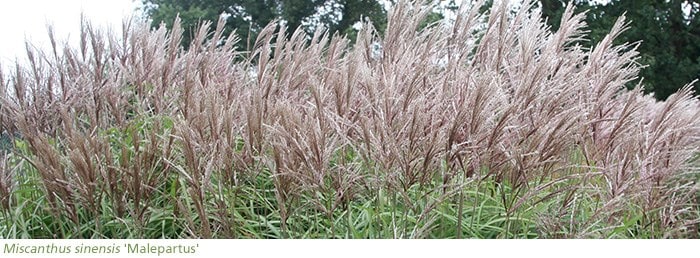
Later flowering plants tend to be tall so the addition of equally tall late-season grasses unites the planting and adds movement as the awns sway. In low light they form a gossamer veil that keeps the garden going, although they must be positioned in a sunny position, preferably in a south-west corner. Forms of Miscanthus sinensis, a graceful grass with feathery awns, include the buff-plumed ‘Gracillimus’ and the finer, pinker-toned ‘Malepartus’. Or you could add the black beads of ‘Transparent’, a delicate form of the willowy Molinia caerulea subsp. arundinacea.
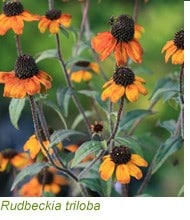 Good perennial combinations include the clump-forming lemon-yellow daisy Helianthus ‘Lemon Queen’ with the wine-red Eupatorium maculatum Atropurpureum Group 'Purple Bush’. They flower almost at the same time, with ‘Lemon Queen’ the later, and both attain the same height. Add a tall helenium, such as the bi-coloured ‘Rauchtopas' and the snazzy Rudbeckia triloba. The latter is a short-lived perennial that flowers its heart up, producing small yellow brown-centred flowers that rise above a tricorn of bright-green foliage. Other good seed producers include monardas, centaureas, annual cosmos and annual calendula. I haven’t found annual sunflowers go down too well with my feathered friends. Earlier in the year birds will devour the seeds of Geranium phaeum, a spring-flowering woodlander. Finally set up your bird table. You’ll be entertained and you’ll be also be helping the birds.
Good perennial combinations include the clump-forming lemon-yellow daisy Helianthus ‘Lemon Queen’ with the wine-red Eupatorium maculatum Atropurpureum Group 'Purple Bush’. They flower almost at the same time, with ‘Lemon Queen’ the later, and both attain the same height. Add a tall helenium, such as the bi-coloured ‘Rauchtopas' and the snazzy Rudbeckia triloba. The latter is a short-lived perennial that flowers its heart up, producing small yellow brown-centred flowers that rise above a tricorn of bright-green foliage. Other good seed producers include monardas, centaureas, annual cosmos and annual calendula. I haven’t found annual sunflowers go down too well with my feathered friends. Earlier in the year birds will devour the seeds of Geranium phaeum, a spring-flowering woodlander. Finally set up your bird table. You’ll be entertained and you’ll be also be helping the birds.




 Cotoneaster
Cotoneaster








